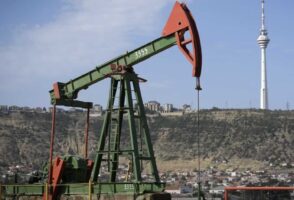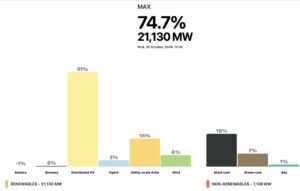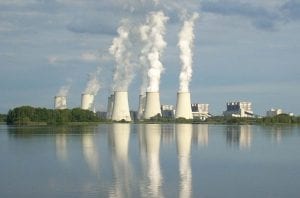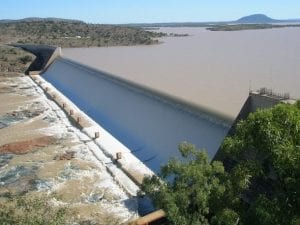In October 2016, Engie officially confirmed that it would close the Hazelwood Power Station and it would cease operating at the end of March 2017.
The announcement came after several years in which investment in renewable energy had largely collapsed – thanks to the Abbott government’s review of the renewable energy target. The few exceptions were a handful of projects supported by ARENA and the ACT (with the one noticeable exception being the White Rock Wind Farm).
While Hazelwood was despised by environmentalists as the most carbon polluting coal power station in Australia (and close to one of the worst in the world), it was very important to the National Electricity Market’s power supplies.
According to analysis prepared for the Australian Energy Market Operator, the lead time for developing and constructing a new coal-fired power station is around eight years. If we wanted to replace it with a new coal power station, we’d be waiting a very long time.
Yet it turns out that simultaneous with the announcement that Hazelwood would shut, the renewable energy sector experienced a dramatic and remarkable revival.
Over the space of just two summers since Hazelwood shut, both the amount of energy we lost since its closure and critically, also the capacity it provided during the peak summer demand period, have been replaced largely by wind and solar.
In the latest edition of the Green Energy Markets Renewable Energy Index we’ve done a review of where the east-coast National Electricity Market got its energy from over this summer and then compared this to the summer of 2016‐17 when Hazelwood was operating.
We’ve looked at summer specifically because this is the time when power demand is at its highest, and reliability is most at threat.
Figure 1 below shows the decline in generation from brown coal last summer and the summer before that compared to the summer of 2016‐17 when Hazelwood was in place. It then shows the changes in generation levels of other fuel types compared to the 2016‐17 summer across the entire National Electricity Market.
 Figure 1 – Change in summer levels of generation in the NEM by fuel type compared to the summer of 2016‐17. Source: Green Energy Markets Renewable Energy Index – derived from NEM Review data.
Figure 1 – Change in summer levels of generation in the NEM by fuel type compared to the summer of 2016‐17. Source: Green Energy Markets Renewable Energy Index – derived from NEM Review data.
In the first summer after Hazelwood shut (the blue bars), it was mainly black coal and gas that filled the gap. But in the most recent summer gas generation had actually dropped below the levels when Hazelwood was operating. Also hydro generation had not changed, while black coal had ceded some of the gains it achieved in the 2017‐18 summer.
Meanwhile, within the space of two summers a range of wind and solar farms had managed to move from investment decision to generating power.
One should also give credit to thousands of households and businesses that added nearly 2,500 megawatts of solar to their rooftops since Engie announced it would close Hazelwood.
The installation of this extra wind and solar capacity meant they generated 2,821 gigawatt‐hours more electricity than the summer of 2016‐17. This almost completely filled the decline in brown coal output of 2,908 gigawatt‐hours over this summer compared to 2016‐17.
Now of course this extra electricity isn’t much good if it doesn’t come at the time we most need it. The time-frame during which demand in the NEM is its highest almost always falls between 11.30am and 5.30pm over summer.
Figure 2 below shows the average amount of capacity provided by renewables in this time period relative to other fuel types over the summer when Hazelwood was in place (2016‐17) and last summer.
Black coal towers over all the other fuel types, but the amount of capacity it provided this most recent summer is barely higher than what it was when Hazelwood was operating. Meanwhile gas is lower.
Instead it has been growth of renewables ‐ and in particular solar – that has filled the gap from the loss of Hazelwood. Brown coal delivered 1,400 megawatts less capacity on average over the 11.30am to 5.30pm peak this summer, compared to the 2016‐17 summer. Meanwhile renewables delivered an additional 2,000MW.
 Figure 2 – Average amount of capacity delivered by fuel type over 11.30am‐5.30pm summer demand peak pre and post Hazelwood closure. Source: Green Energy Markets Renewable Energy Index – derived from NEM Review data. Note that 11.30am to 5.30pm period is for the NEM time – which is eastern standard time not daylight savings time.
Figure 2 – Average amount of capacity delivered by fuel type over 11.30am‐5.30pm summer demand peak pre and post Hazelwood closure. Source: Green Energy Markets Renewable Energy Index – derived from NEM Review data. Note that 11.30am to 5.30pm period is for the NEM time – which is eastern standard time not daylight savings time.
Solar is now the second largest source of generating capacity in the NEM over the 9am to 5pm period in Summer, ahead of brown coal, gas and hydro.
If we delve into the detail of the time profile of generation across the 9 to 5 period we see solar generation on average exceeds that of brown coal and gas across every hour until 3pm at which point it drops slightly below brown coal, while remaining above gas until 4pm.
By the 2021‐22 summer we expect solar output will manage to exceed these two fuel types up to 5pm as well, given Green Energy Markets projects a doubling in solar capacity by then.
 Figure 3 – Average capacity supplied by solar, gas and brown coal by hour over Jan‐Feb 2019. Source: Green Energy Markets Renewable Energy Index – derived from NEM Review data. Note: each hour band covers the hour after the time indicated (4pm covers 4pm until 5pm). Also time periods are for the NEM time which is eastern standard time not daylight savings time.
Figure 3 – Average capacity supplied by solar, gas and brown coal by hour over Jan‐Feb 2019. Source: Green Energy Markets Renewable Energy Index – derived from NEM Review data. Note: each hour band covers the hour after the time indicated (4pm covers 4pm until 5pm). Also time periods are for the NEM time which is eastern standard time not daylight savings time.
Of course we clearly still need fossil fuel plants to keep the lights on at present. On 26 January Victorians experienced load shedding for a few hours that wouldn’t have happened if three generating units at Yallourn and Loy Yang A weren’t out of action that day. It is hardly a revelation that as the sun goes down, output from solar systems also recedes. And yes, the wind varies.
However, what this data reveals is that the addition of solar and wind capacity has helped, not hindered the reliability of our power supplies.
It would naturally be great if wind and solar was just like a hydro plant that you could turn up and down whenever you wanted. But they can be relied upon to provide significant amounts of power during peak demand periods.
Solar in particular is helping to compress the period over which gas power plants are needed to a much smaller space of time. This means that rather than prices spiking from 12 noon until 8pm, they will in future be contained to a narrower period of time. This will particularly help many businesses that tend to wind up operations not long after 5pm (NEM time which is 6pm in daylight savings time).
In addition, if the price spikes are concentrated to a narrow window of 5pm until 8pm it presents a much more manageable problem for demand response and battery storage to address.
Asking a business to wind back operations for an hour or two, particularly if after 5pm, is much less challenging than doing it over eight hours.
In terms of residential demand management, this becomes more feasible when you can pre-cool the house while the sun is out and then just need to buy an hour or two of constrained output from an air‐conditioner. Lastly battery costs are largely a function of the duration of storage we need.
There are still plenty of challenges we need to resolve on the path to achieving zero emission electricity supplies, but suggestions that growth of renewables pose an immediate and unavoidable threat to reliability are clearly completely ridiculous.
Tristan Edis is Director – Analysis & Advisory with Green Energy Markets. Green Energy Markets assists clients make informed investment, trading and policy decisions in the areas of clean energy and carbon abatement.










